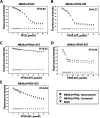Perfluorooctane Sulfonate (PFOS) and Related Compounds Induce Nuclear Receptor 4A1 (NR4A1)-Dependent Carcinogenesis
- PMID: 40066943
- PMCID: PMC12015964
- DOI: 10.1021/acs.chemrestox.4c00528
Perfluorooctane Sulfonate (PFOS) and Related Compounds Induce Nuclear Receptor 4A1 (NR4A1)-Dependent Carcinogenesis
Abstract
Polyfluoroalkyl substances (PFAS) are widely used industrial compounds that have been identified as contaminants in almost every component of the global ecosystem, and in human studies, higher levels of PFAS have been correlated with increased incidence of multiple diseases. Based on the results of human and laboratory animal studies, we hypothesize that the orphan nuclear receptor 4A1 (NR4A1) may be a critical target for some PFAS such as the legacy linear polyfluorooctanesulfonate (PFOS) and other sulfonates. We show that PFOS and related compounds bound the ligand binding domain (LBD) of NR4A1 and induced the growth of several cancer cell lines and enhanced tumor growth in an athymic nude mouse model. Using NR4A1-responsive rhabdomyosarcoma Rh30 cells as a model, PFOS induced NR4A1-dependent cell proliferation and Rh30 cell migration and invasion. Moreover, in Rh30 cells, PFOS also induces several NR4A1-regulated genes including the PAX3-FOXO1 oncogene and downstream gene products, and in a chromatin immunoprecipitation assay, PFOS does not decrease NR4A1 binding to the promoter. These results demonstrate that PFOS is an NR4A1 ligand and enhances tumorigenesis through the activation of this receptor.
Conflict of interest statement
The authors declare no competing financial interest.
Figures







References
-
- Wang D. Z.; Goldenman G.; Tugran T.; McNeil A.; Jones M.. Per- and polyfluoroalkylether substances: identity, production and use; Nordisk Ministerråd: Copenhagen, 2020.
-
- Evich M. G.; Davis M. J. B.; McCord J. P.; Acrey B.; Awkerman J. A.; Knappe D. R. U.; Lindstrom A. B.; Speth T. F.; Tebes-Stevens C.; Strynar M. J.; Wang Z.; Weber E. J.; Henderson W. M.; Washington J. W. Per- and polyfluoroalkyl substances in the environment. Science 2022, 375 (6580), eabg906510.1126/science.abg9065. - DOI - PMC - PubMed
MeSH terms
Substances
Grants and funding
LinkOut - more resources
Full Text Sources
Research Materials
Miscellaneous

